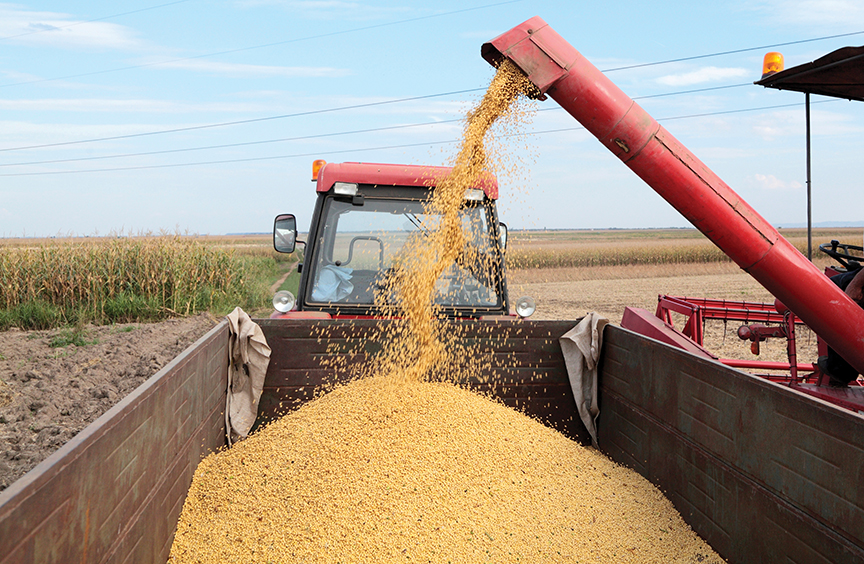 Farming is the sixth most dangerous job in the United States, according to a 2014 report from TIME magazine.
Farming is the sixth most dangerous job in the United States, according to a 2014 report from TIME magazine.
Those at Indiana Electric Cooperatives want you to be aware of a hazard on farms — electrocution. Every year, 62 farm workers are electrocuted in the United States, according to the U.S. Department of Labor Occupational Safey and Health Administration.
“These deaths can be prevented,” said Tom VanParis, CEO of Indiana Electric Cooperatives. “It’s important that those who live and work on farms know the risks and understand how they can unknowingly come into contact with electricity.”
The most common risk of electrocution for farm workers, according to the Iowa State University Extension and Outreach, comes from overhead power lines because tall equipment, such as grain augers, combines and raised dump truck beds, can easily become entangled in the lines.
Grain bins also pose a danger. The National Electrical Safety Code requires power lines to be at least 18 feet above the highest point on any grain bin with which portable augers or other portable filling equipment are used.
Farmers are encouraged to call their electric cooperative if they plan to install new grain bins or if they are concerned about the proximity of power lines to existing structures or equipment.
Farm owners are responsible for making sure all components of the farm’s electrical system are functioning correctly to protect themselves and their workers. The Indiana Department of Agriculture suggests property owners contact local government offices to find out about any local codes for installing electrical distribution systems or building electrical fences.
“The main distribution system on a farm should be large enough to accommodate present demand and future expansion,” VanParis said. “If you have expanded your farm in recent years or simply want to make sure all components of your farm’s electrical system are functioning properly, please contact your electric cooperative.
Livestock farms often use electric fencing to contain animals. Indiana Electric Cooperatives reminds farmers to regularly monitor and service their electric fence chargers to ensure a safe amount of current is running through the wire. A volt meter can be used to test that the fence is functioning properly.
Many farms have standby generators on hand in case of power outages.
“When a standby generator is used on a single-phase system, it must be connected to the farm’s wiring system through a double pole, double-throw switch,” VanParis said. “This switch disconnects the farm’s electric system from the cooperative’s lines during an outage, which prevents backfeed to keep our linemen safe.”
Another safety tip for farmers is to install waterproof and dustproof electrical boxes and outlets. The Virginia Cooperative Extension points out farms are dusty, moist and corrosive environments. Taking these types of precautions makes using electricity safer and more reliable.
Indiana Electric Cooperatives stresses the importance of electricity to Indiana’s agricultural industry. Electrical safety is critical for making Indiana’s farms productive.
Sources: TIME Magazine, U.S. Department of Labor Occupational Safety and Health Administration, Iowa State University Extension and Outreach, Indiana Department of Agriculture, Virginia Cooperative Extension
Power lines and farm equipment: Know what to do
With farmers returning to the field, Indiana Electric Cooperatives reminds them of the dangers of power lines.
If you’re inside the machinery when coming in contact with a downed power line…
- If you can, drive safely away from the downed power line and the source of electricity. Travel at least three tractor lengths, or about 40 feet, before stopping.
- If you can’t drive or you are injured, it’s best to stay where you are until help arrives.
- If you must get out of the machinery (for example, if the machinery is on fire), don’t touch the machinery and the ground at the same time with any part of your body or clothing.
- With the door open, prepare to jump. Stand up, elbows tucked into your stomach and your hands held close to your chest.
- Jump out and away from the machinery, taking care to land with your feet together and touching. Don’t stumble.
- Shuffle away with your feet touching. Don’t stop until you’re at least three tractor lengths away from the machinery.
- Call 911 and ensure that no bystanders come within 40 feet of machinery.
- Once away from the equipment, never attempt to get back on or even touch the equipment.
If you’re outside the machinery when you notice a farmer comes in contact with a downed power line…
- Stay at least three tractor lengths away.
- Tell the person on the machinery to stay where he or she is.
- Call 911 and ensure no bystander moves within 40 feet of machinery.
Are you using the right equipment?
Farms are home to power tools, heavy equipment and multiple areas of electricity, including barns, machinery sheds and livestock buildings. Keep the farm’s electrical system operating safely by using these items.
- Ground fault circuit interrupters monitor the current flow to an electrical device, protecting against shocks from faulty electrical equipment in damp areas.
- Double-insulated power tools reduce the risk of electrical shock. Tools and equipment should also carry the label of a recognized inspection and approval agency, such as Underwriters Laboratories.
- Employ lockouts to prevent electrically-powered equipment from accidentally starting when being serviced or repaired.
- Using a volt meter, regularly test electric fences to ensure proper functioning.
Source: Virginia Cooperative Extension, Michigan State University Extension
Farming safety by the numbers
6: Farming is the sixth most dangerous job in the United States.
55: The minimum distance in feet between a power line and grain bin wall.
243: The number of agricultural workers who suffer a serious lost-work-time injury each day.
570: The number of agricultural workers who passed away from work-related injuries in 2011.
Source: TIME Magazine, NRECA, U.S. Department of Labor Occupational Safety and Health Administration



